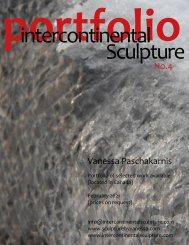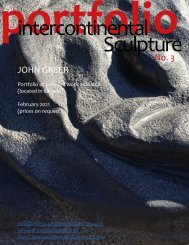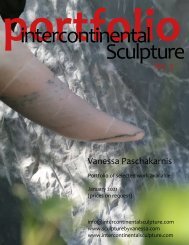in touch Intercontinental Sculpture
Quarterly magazine showcasing the work of Intercontinental Sculpture Inc. Give your world more dimension and enrich your life through sculpture.
Quarterly magazine showcasing the work of Intercontinental Sculpture Inc.
Give your world more dimension and enrich your life through sculpture.
Create successful ePaper yourself
Turn your PDF publications into a flip-book with our unique Google optimized e-Paper software.
The Shield, 2020 is carved of a particularly
strong white Italian marble
from the Canaloni quarry above Carrara.
Its grain is so tight, that it rings
like a bell. It is mounted on a tapered
pin that allows it to be free standing
with a stainless plate fastened beneath
the surface. The Shield refers
back to a seashell, the sand dollar,
found on the shore. It’s detailing reflects
on a core and two halves, thus
creating a presence that is fragile,
yet embracing us as a thing.
Luna d’Oro, 2019 Egyptian Marble,
48cm x 3cm x 50cm; This small
shield based on a flat seashell bears a
band of marks, delineating its shape.
Its golden colour reminds one of the
moon in a night sky.
Falena d’Oro 1, 2019 Egyptian Marble,
90cm x 63cm x 3.5cm; A moth
is a creature of the night, that when
bathed in golden light, either merges
with the surface it finds itself on,
or starts unfolding, soaring into the
night to find light.
Falena d’Oro 2, 2019 Egyptian Marble,
100cm x 70cm x 4cm;
Here the moth is like an origami folded
piece of paper. Yet the surface
bears marks and scratches alluding
to it being a tender shield on the
wall, before being the delicate creature
of the night.
Bestia Romana, 2009 Travertine,
Statuario Marble, 96cm x 100cm
x 183cm; This sculpture is a heavy
solid piece with horns permanently
glued in. The presence of this
sculpture emphasizes the duality of
nature through it’s permanence on
the one hand and it’s lightness and
unpredictability on the other, here
represented by the white horns that
sling around the beast’s head without
ever touching it. The original
shape forces you to circumnavigate
the sculpture as it is unpredictable
in its form. “Bestia Romana” gets its
name from the large block of Roman
Travertine that it towers with pride
and presence.
9







